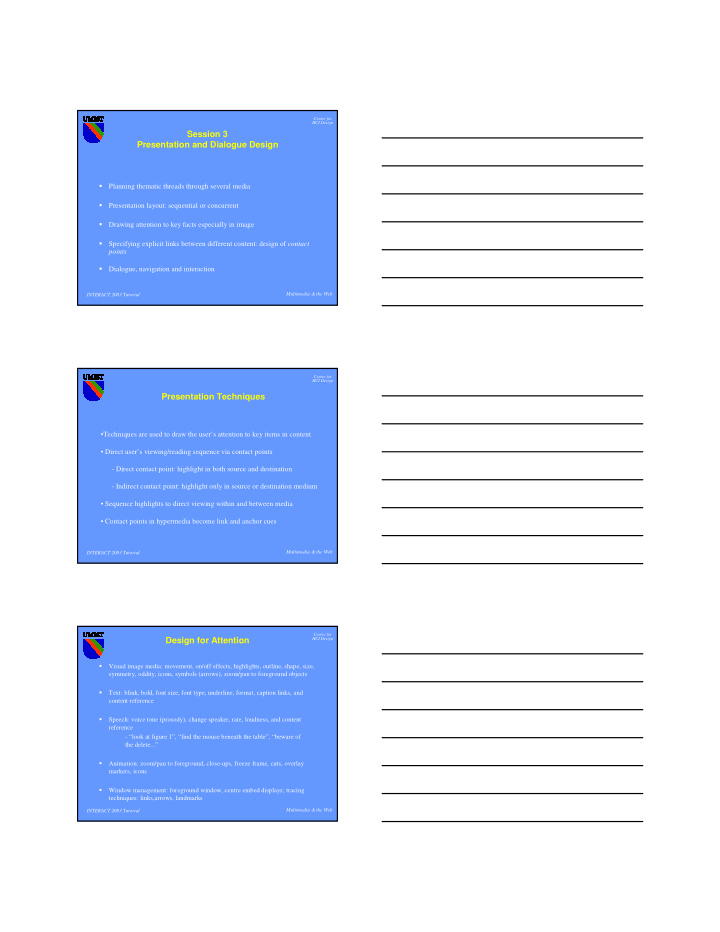



Centre for HCI Design Session 3 Presentation and Dialogue Design � Planning thematic threads through several media � Presentation layout: sequential or concurrent � Drawing attention to key facts especially in image � Specifying explicit links between different content: design of contact points � Dialogue, navigation and interaction INTERACT 2003 Tutorial Multimedia & the Web Centre for HCI Design Presentation Techniques •Techniques are used to draw the user’s attention to key items in content • Direct user’s viewing/reading sequence via contact points - Direct contact point: highlight in both source and destination - Indirect contact point: highlight only in source or destination medium • Sequence highlights to direct viewing within and between media • Contact points in hypermedia become link and anchor cues Multimedia & the Web INTERACT 2003 Tutorial Centre for Design for Attention HCI Design � Visual image media: movement, on/off effects, highlights, outline, shape, size, symmetry, oddity, icons, symbols (arrows), zoom/pan to foreground objects � Text: blink, bold, font size, font type, underline, format, caption links, and content reference � Speech: voice tone (prosody), change speaker, rate, loudness, and content reference - “look at figure 1”, “find the mouse beneath the table”, “beware of the delete...” � Animation: zoom/pan to foreground, close-ups, freeze frame, cuts, overlay markers, icons � Window management: foreground window, centre embed displays; tracing techniques: links,arrows, landmarks Multimedia & the Web INTERACT 2003 Tutorial
Centre for HCI Design Contact point example Text and speech linked to image with boundary effect INTERACT 2003 Tutorial Multimedia & the Web Centre for HCI Design Contact point: text, speech & image visible highlights speech contact point N ext, the protein pyrimidine complex absorbs light This causes the D NA to be repaired from the visible range Multimedia & the Web INTERACT 2003 Tutorial Centre for HCI Design Contact points: text to video segments buttons access video segments Multimedia & the Web INTERACT 2003 Tutorial
Centre for HCI Design Interaction � Interaction engages users: motivating also improves learning � Ideas? - interactive metaphors for navigation, games, quiz, user as actor in presentation � Dialogue plans from task analysis, scenarios � Prototype and/or storyboards for early evaluation; feedback from users INTERACT 2003 Tutorial Multimedia & the Web Centre for HCI Design Structuring Dialogues � Dialogue sequences based on scenarios, use cases or task analysis � For information-intensive applications, dialogue becomes access and navigation problem � Navigation links & controls based on information architecture: list, hierarchy, network, lattice � Design access paths are menus (hierarchies), links and maps (networks), tables (lattice) � Add controls for media resources, user interaction/ manipulation Multimedia & the Web INTERACT 2003 Tutorial Centre for Navigation Metaphor: Example HCI Design Conceptual explanation: notion of direction and navigation Abstract objects and actions…… space, vectors, directions, move on bearing Metaphor of real world used with designed image and text Multimedia & the Web INTERACT 2003 Tutorial
Centre for HCI Design Navigation/Control Metaphors � Zoom/Pan controls � Compass metaphor: movement within image/ structure � Timeline: navigation by sequence, date, history � Card index: content structure � Agent metaphors: move self/presence � always test metaphors; your interpretation might not be the user’s INTERACT 2003 Tutorial Multimedia & the Web Centre for HCI Design Simple controls Browser style controls, more complex metaphors, e.g. compass to navigation within an image or media stream Multimedia & the Web INTERACT 2003 Tutorial Centre for HCI Design Navigation Controls � Web Browser-style controls: Back, Forward, Home � Video metaphor controls for dynamic media << | Stop| Play | >> � Content-addressable browsing: thumbnails, video segments � Bookmarks, visit-lists, overview maps of navigation space, you-are-here markers � Guided tours, active links (destination hints & queries) Multimedia & the Web INTERACT 2003 Tutorial
Centre for HCI Design Pondworld (Rogers & Scaife, 1999) Integrates real world view with abstract diagram + interaction INTERACT 2003 Tutorial Multimedia & the Web Centre for HCI Design Summary of Session 3 � Dialogue network diagram/site map: specify navigation paths, dialogue/interaction � Facilities provided for navigation support � Cues, prompts & metaphors for navigation and interactive support; predictability � Feedback, status messages, and presentation; observability and understanding � Designs for interactive functions to support user’s task (or learning) Multimedia & the Web INTERACT 2003 Tutorial Centre for HCI Design Conclusions � Multimedia needs to be used more effectively and knowledge of psychology can help � Planning a coherent message and presentation is vital; design trade-offs between effective presentation, attraction and engagement. � Design of multimedia is important to deliver key messages: media selection and design for attention � Integration of multimedia and control of attention also vital: picking out the key points, making the thematic thread clear Multimedia & the Web INTERACT 2003 Tutorial
Centre for HCI Design For more information Sutcliffe, A.G. Multimedia and virtual reality: Designing multi-sensory user interfaces Lawrence Erlbaum Associates 2003 INTERACT 2003 Tutorial Multimedia & the Web
Recommend
More recommend